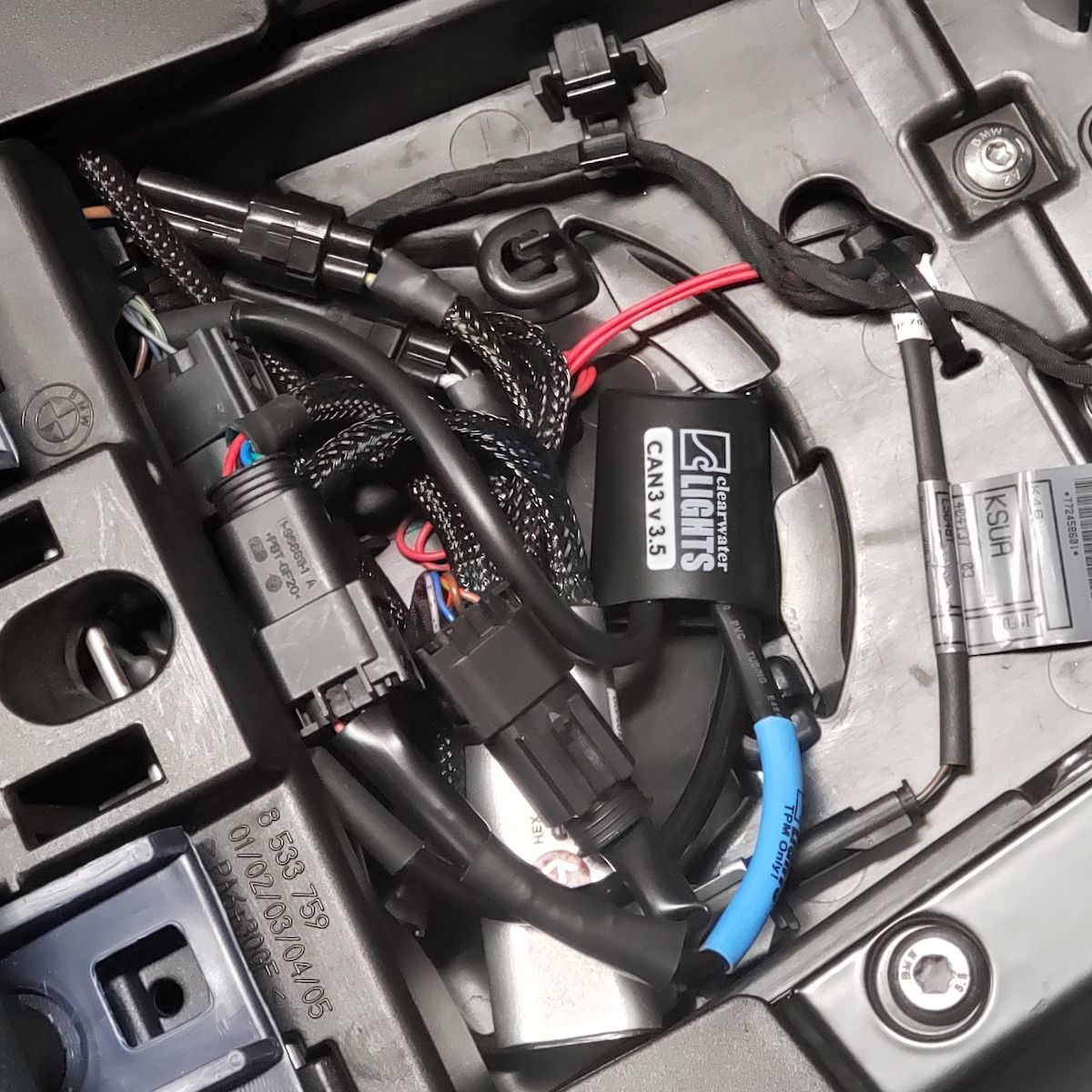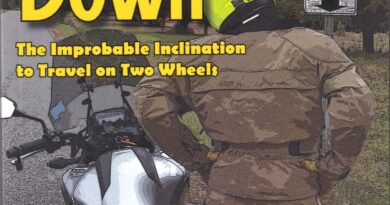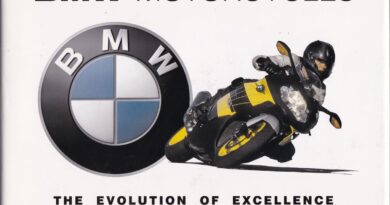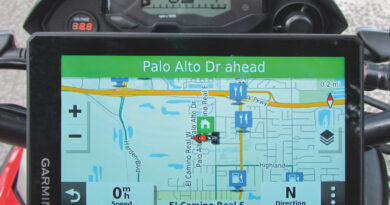Clearwater Darla lights on an R 1250 RS
One of the many excellent reasons to attend an MOA rally is the discount shopping offered by on-site vendors. In addition to seeing goods in person (as opposed to ordering them based on pictures or spec sheets), you can discuss your needs and product tech details with company staff instead of a potentially uninformed salesperson at your local shop, and in many cases you can have purchases professionally installed on the spot by experienced techs who perform these same services all the time. I did exactly this at The 50th in 2023 with a set of Clearwater’s Darla lights for my R 1250 RS.
I hadn’t planned on making such a purchase. I’d already augmented my daytime conspicuity and added a few lumens to my night rides with Evolution LED turn signal inserts from Cyclops. These glow bright white when not flashing yellow and they’re inexpensive. I understood they weren’t nearly as powerful as standalone auxiliary lighting, but they’re a good value and I very rarely ride at night anymore. I’d found my bike’s stock headlights adequate, if not outstanding, when I ended up coming home late, but I hadn’t taken into consideration I was always on familiar roads with at least a few streetlights overhead. When I rode back to my hotel from the rally after dark, I had to contend with completely unfamiliar backroads lacking any overhead illumination—a very different experience! It was scary, like riding through ink. I was immediately intent on improving my ability to see during subsequent nighttime trips at the rally and anytime I might get caught in a similar situation in the future.

A riding buddy with the same bike who already had Darlas on his machine told me he’d never wanted more illumination. These lights happen to mount very simply to our bikes’ lower fork tubes using brackets that bolt on where our front fenders attach (other mounts are available, too). With this recommendation and no intention of doing much nighttime riding, I chose this model at the least powerful end of Clearwater’s regular 12-volt lineup (the even-smaller Glendinas are for six-volt systems). I thought it prudent to spend no more than necessary on something I’d only use occasionally, and even the Darlas are not cheap!

Clearwater Lights is a family-run operation with a reputation for making expensive kit, with the cost justified by superlative build quality, durability and performance. Their products are made in the U.S., with industry-leading Cree LEDs and related components, rugged CNC-machined or forged-from-billet housings, hard-anodized and/or powder-coated surface treatments, and 6061 aluminum brackets with stainless steel hardware. Their wiring is silver-plated, fine-strand copper with hi-temp Teflon insulation, incorporating Posi-Product connectors, adhesive-coated shrink-wrap, and heavy-duty polyethylene sheaths with silicone lubricant for vibration resistance. Products carry a two-year warranty, with personalized service and support on a case-by-case basis afterward.
Each Darla is 2.2” wide and 2” deep, weighs seven ounces, sports three high-powered LEDs configured for a driving beam projection, and consumes 24 watts at full power with a maximum output of 2,400 lumens. They’re engineered and marketed as primarily fog/conspicuity lights, not hard-core driving lights designed to hurl a bazillion photons into the next county. Nevertheless, they deliver a broad swath of increased nighttime illumination beyond what my stock headlight provides at close and moderate range, and they make distant reflective surfaces (road signs, animal retinas) visible much sooner, even if they don’t bathe the far away landscape in brilliant light. If I did more nighttime traveling, I’d spend the extra coin for more powerful auxiliary lighting, but I’m content with my Darlas. They boost nighttime illumination enough to relieve the fright I felt on that first night of the rally, and they increase my daytime conspicuity dramatically—a benefit I value every time I ride.

“Selective Yellow” slip-on lenses make these lights really pop visually during the day or bad weather by filtering all wavelengths but the one to which our eyes are most sensitive. They grab so much attention partly because of the color itself and partly because of this hue’s extraordinary contrast against typical backgrounds compared to white light, even the glare of reflected sunlight. Nighttime illumination is maximized by simply pulling these covers off, no tools required. Each cover comes with a clear lens, too, if desired to ease cleaning or add a layer of impact protection. The triangular arrangement of any pair of auxiliary lights with a motorcycle’s headlight not only stands out in traffic, but also helps motorists judge distance and movement more accurately; an approaching triangle changes dimension more noticeably than an approaching dot.
Since Clearwater staff installed my lights for me at the rally, I can’t provide first-hand commentary on the process, but the installation instructions for any light/bike combination are available on Clearwater’s website. Judging by the information for the Darlas on my motorcycle, the process is straightforward and should be well within the capabilities of the average home mechanic. Note that any model light is available in multiple kits that include wiring, switchgear, and bracketry appropriate for specific applications. For example, BMWs with a wonderwheel can use it to adjust the Darlas’ brightness, whereas those without this controller get a handlebar-mounted dial to serve the same function.
Also noteworthy in the Clearwater Lights package for motorcycles equipped with CANbus electrics is the inclusion of their CANopener module, which taps into the CANbus through an existing accessory plug without setting off fault codes or interfering with the signals traveling through such systems (integrated power/ground leads go directly from CANopener to battery). The CANopener reads information from controls like the horn and headlight dimmer switch, and from sensors like the day/night ambient light detector you may not even realize your bike has, then changes the behavior of the lights accordingly (more on this later). It can also coordinate additional electronics, like Clearwater’s flashing “Billie Brake Lights.”

In my review of the Cyclops lighting, I discussed using Hex’s Gen-2 ezCAN (reviewed separately in the 1/23 issue of ON, or the 7/17/22 post on bmwownersnews.com) which also accesses the CANbus system and can be programmed to control multiple auxiliary electronics. While there is some overlap in their functions, the ezCAN and CANopener are significantly different devices. Keep in mind LED lights are digital, not analog. Similar to the difference between a fuel injector and a carburetor, LEDs are modulated by turning them on and off very quickly (hundreds of times a second), rather than by adjusting the flow of electrons on a gradient. Such “pulse width modulation” is managed for the Cyclops LEDs by the ezCAN. You can dial their brightness up or down with the wonderwheel (or by connecting the ezCAN to a laptop and using its programming software), and the ezCAN will transmit power to the LEDs with shorter or longer gaps/pulses, causing the lights to appear brighter or dimmer. Clearwater builds pulse width modulators into each light unit, so the CANopener doesn’t perform this duty.

You might think this would create problems if you want to use both an ezCAN and a CANopener on the same bike, but it can be done; that’s how it is on my bike. The CANopener simply connects inline with one of the ezCAN’s output channels, allowing everything from the ezCAN to pass through to the related componentry. This arrangement does make adjusting the lights separately a little tricky, since they both use the Wonder Wheel. What if I want the Cyclops lights at full brightness during the day when my low beams are on, but I only want the Darlas at 30% brightness in that same scenario? The Cyclops lights come on whenever the ignition is active, even without the motor running, whereas the Darlas don’t come on until the motor does. I can set the Darlas with the motor running, then turn the bike off and back on without restarting the motor. Now the Darlas are “asleep” and I can set the Cyclops lights independently. Both sets of lights will then hold their respective settings going forward.
My combination of motorcycle, Darlas, and CANopener allows many adjustments using several existent controls, including the Wonder Wheel, turn signal switch, and front brake lever. Manipulating these in various sequences not only changes auxiliary light brightness, but whether or not they strobe when the horn is blowing or go to full power when hi-beams are flashed prior to overtaking. They can also be set to dim when turn signals are activated, or to flash with hazards. As alluded to earlier, settings can be made separately for daytime and nighttime operation (using the bike’s built-in photocell to distinguish these), and separately for use with low-beams and hi-beams. If Clearwater’s Billie Brake Lights are installed, their behavior can be modified via similar means.

I settled on the following configuration for my Darlas: 100% while running high beams, when I need maximum illumination and I’m not concerned about blinding oncoming traffic; 30% while running low-beams at night, as this provides plenty of additional conspicuity without obnoxious glare; 70% while running low-beams in daylight, which delivers un-ignorable conspicuity, but stops short of being an infuriating distraction. Before the Darlas, I would keep my high beams on all the time to boost my conspicuity. Now I’m much more visible during the day with only my low beams and the Darlas, and I reserve my high beams for empty roads at night.
The fender-mount kit for my bike carries an MSRP of $669. If purchased at the same time, the Selective Yellow slip-on lenses cost another $30 ($40 if bought separately). With Clearwater’s rally discount, I got all this hardware for $594. I don’t know what I’d have paid my local shop to install the system, but I’m sure it would’ve been a lot more than the $100 Clearwater charged me at the rally. While the installation is not technically complicated, it can be time-consuming (1-3 hours). With all the plastic R&R required on my bike, the project would definitely require more than an hour of labor, currently $125+ in my area. See Clearwater’s website for bundle discounts and simplified wiring when purchasing more than one setup at a time. For instance, Darlas can be added to other Clearwater lights that already have branches in their wiring for the Darlas, eliminating the need for/cost of wiring normally included with them.
Even with my rally savings, $694 is a lot to spend on something for which I hadn’t felt any need during two years of owning this motorcycle. While I may not have much occasion to appreciate the Darlas’ additional nighttime illumination, I feel better knowing it’s there if I need it unexpectedly. I never want to repeat that half-blind ride on the rally’s first night! More importantly, I’m confident my conspicuity during the day is worlds better. It’s virtually inconceivable to me that a motorist could overlook me from the front now, even on the brightest days when my other lights don’t stand out much.



